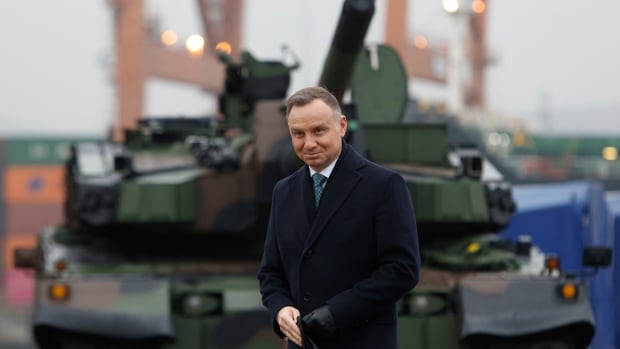Global Courant 2023-05-31 13:00:00
A windswept pier at a naval port in Gdynia, Poland, was the scene of an extraordinary display last December – one that the Canadian defense community looks on with envy today.
Lined up rail to rail on the pier that day, their gun barrels up, were two dozen Thunder K9-A1 self-propelled howitzers, manufactured in South Korea. 10 Black Panther K2 54-ton main battle tanks were parked nearby.
The armored vehicles and big guns represented the forefront of a $13 billion US blockbuster defense deal between Warsaw and Seoul.
What made the scene exceptional was the fact that the contract between the two nations was signed barely four months before the big tanks and guns rolled up the pier.
In the world of defense procurement, that’s light speed. The deal was a talking point ahead of the Canadian Association of Defense and Security Industry’s annual trade show, which begins Wednesday in Ottawa.
A worker puts a Polish flag on a South Korean Black Panther K2 tank at the Polish naval port of Gdynia, Poland Dec. 6, 2022. (Michal Dyjuk/Associated Press)
South Korea plans to deliver 180 K2 tanks, 212 K9 howitzers and 288 K239 Chunmoo K-MLRS (Korean Multiple Launch Rocket System) to Poland, similar to the American-built HIMARS system, which has proved crucial to the defense of Ukraine in its war with Russia.
And that’s just the tip of the iceberg. Ultimately, Poland plans to buy up to 1,000 South Korean tanks, 688 howitzers and 48 FA-50 fighter jets, which can be used as trainers and light combat aircraft.
It is a massive rearmament program, driven partly by Poland’s need to replenish stocks of equipment donated to Ukraine and partly by a fear of what might come next if Russia succeeds in overthrowing the Kiev government.
“We decided to do it as soon as possible because we are the front country,” Tomasz Grodzki, president of the Polish Senate, said in a recent interview with CBC News.
The speed of Poland’s procurement project is in stark contrast to the pace of military procurement in Canada. Ottawa still has no timetable for a plan – announced in March by Defense Minister Anita Anand – to accelerate the purchase of portable anti-tank missiles, unmanned counter-drone systems and ground-based air defense systems for troops in Latvia at an “urgent operational base”.
A plan to accelerate the purchase of military equipment announced by Defense Minister Anita Anand in March still has no timeline. (The Canadian Press/Adrian Wyld)
Defense procurement expert Dave Perry blames Canada’s lack of urgency.
“Poland is right on the border and I think it has a much clearer focus and a much greater sense of urgency that its troops need equipment, not 10 years from now, or 15 or 20 years from now, but they need equipment now “, he said. Perry, vice president of the Canadian Global Affairs Institute. The Institute has occasionally hosted conferences sponsored by defense contractors.
“Even the projects that we consider urgent requirements just seem to have projects moving to the front of a slow moving line, rather than having a unique or special process to really speed them up to make sure we get that material in get hands of troops as soon as possible, or at least for when they will need it.”
Canada must give up ‘illusions’ about Russia
In Poland, unlike Canada, there is no political disagreement over defense policy and military purchases, and the deal with South Korea was passed quickly.
“We decided unanimously – both sides of the political scene in Poland – not to delay,” said Grodzki, who added that Poland’s proximity to Russia – and its long history of being controlled or absorbed by its neighbor – is a important factor in the position of his country. determination to arm.
The defense deal is expected to boost Poland’s defense spending to four percent of its gross domestic product, he added.
Grodzki said it is not for him to judge an ally’s internal politics, but he urged Canadian politicians on an individual level to abandon their “illusions … about the nature of Russia”.
“I understand (Canada), it’s a long way from Ukraine, from Russia. So maybe it’s a little harder to understand that the world is changing,” he said.
Tomasz Grodzki, president of the Polish Senate, says Canada’s “distance” from Russia could make it “more difficult to understand that the world is changing”. (Czarek Sokolowski/The Associated Press)
Polish Prime Minister Mateusz Morawiecki will visit Canada on Friday. He and Prime Minister Justin Trudeau are expected to discuss “the regional defense and security challenges posed by Russia’s relentless and unjustified war of aggression against Ukraine,” according to a statement from the Prime Minister’s Office.
During Trudeau’s recent visit to South Korea, there was intense speculation in local media whether Canada would consider buying submarines from Daewoo Shipbuilding & Marine Engineering (DSME) and Hyundai Heavy Industries (HHI).
A senior Canadian government official, speaking in the background, said the topic of submarine buying was not raised by either side when Trudeau met with South Korean President Yoon Suk Yeol.
Since the Russian invasion of Ukraine, South Korean companies have strengthened their presence in the global arms market. The country’s ambassador to Canada, Lim Woongsoon, said this was not entirely motivated by a desire to fill the gap in the international arms shortage left by the war.
Like Poland, South Korea has a belligerent neighbor.
“Under the growing threat of North Korea, (South) Korea must always be ready to defend ourselves,” the ambassador said. “That’s why we have a standing army of more than 500,000 men, with a huge production line for the large-scale delivery of weapons systems” to meet the country’s domestic needs.
The abundance of equipment is one of the reasons why the country was able to quickly deliver armored vehicles to Poland.
South Korea’s arms exports rose to $17.3 billion last year, thanks in part to the deal with Warsaw, where most tanks will be built in a factory in Poland — something Lim says is encouraged by his country’s military export policy.
“Our military export policy is that we aim to build security partnerships with the purchasing country, not just a one-time business transaction,” he said.
“Therefore, we are quite open and generous to technology transplantation and joint local production in the protection contract. Since we see the military export as the beginning of our long-term security partnership, we are ready to provide all parts and parts needed for maintenance . and upgrade over time.”
Though it arms Poland, a NATO ally, Seoul shuns arms sales to Ukraine.
Russian President Vladimir Putin publicly threatened South Korea last October, saying that if it armed the government in Kiev, he would send advanced weapons to North Korea.








